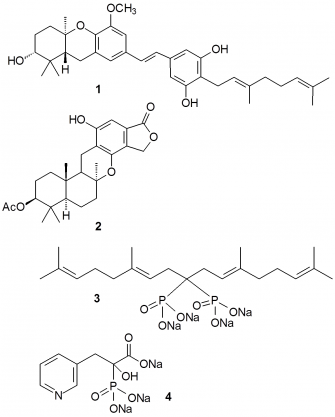Our research interests include development of new strategies for organic synthesis based on organophosphorus compounds, design and synthesis of metabolic probes, and synthesis of biologically active natural products.
The natural products we target often are terpenoids. Current targets include potential anti-cancer agents such as the schweinfurthins (e.g. 1) whose cellular target has not yet been identified, and kampanol (2) which is an inhibitor of the enzyme farnesyl:protein transferase (FTase, EC 2.5.1.58). Our currently preferred route to these complex terpenoids is based on a cationic cascade cyclization. Total synthesis of complicated targets often requires development of new approaches to the formation of a particular substructure. This is part of the challenge, and the opportunity, of this research. A major focus of our efforts has been development of new methods for formation of carbon-phosphorus bonds and new applications of organophosphorus compounds in organic synthesis. For example, we have explored use of electrophilic phosphorus reagents for preparation of b-keto phosphonates and discovered routes based on rearrangement of vinyl phosphates as well as strategies based upon the reaction of enolates with P(III) halides. These methodologies lead to new strategies for facile assembly of complex molecules, and become key parts of our total syntheses.
Our interests in terpenoid synthesis and organophosphorus chemistry have combined in an investigation of terpene metabolism. In collaboration with Prof. Raymond J. Hohl (Internal Medicine and Pharmacology) we have designed several families of terpenoid phosphonates (e.g. 3) as analogues of farnesyl pyrophosphate. The pyrophosphate serves as a key intermediate in steroid biosynthesis and as a metabolic reagent for addition of lipophilic terpene units to proteins, and we are seeking more potent inhibitors of enzymes that use FPP as a substrate. Through work with Prof. Sarah A. Holstein (Internal Medicine), we are trying to develop new inhibitors of the downstream enzyme geranylgeranyl protein transferase II (e.g. new analogues of PEHPC, 4). Through synthesis and bioassay of such compounds we hope to clarify their value as potential anti-cancer agents.
Acknowledgments
Financial support from the Roy J. Carver Charitable Trust, the National Institutes of Health, the Children’s Tumor Foundation, and the UI Graduate College is gratefully acknowledged.

Schweinfurthins (1), Kampanol A (2), Terpenoid Phosphonates (3), New Analogues of PEHPC (4)
The synthetic targets of the Wiemer Group include both natural products and the products of our collective imagination.